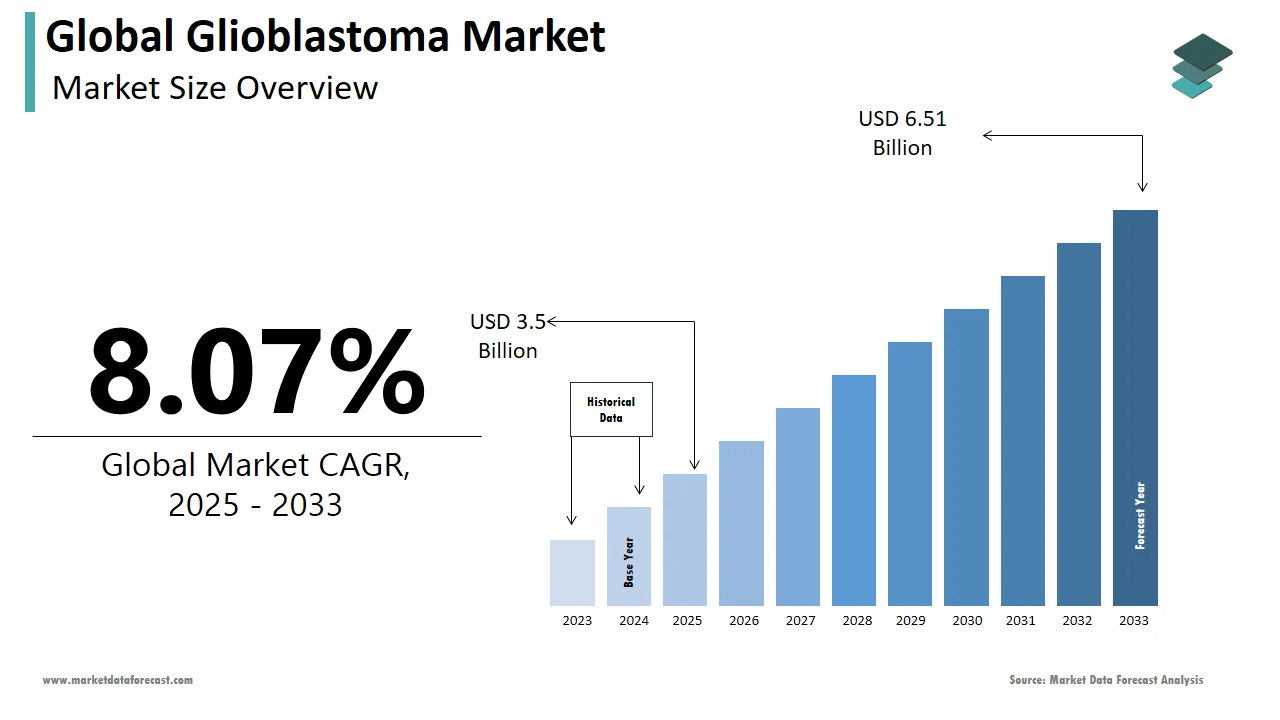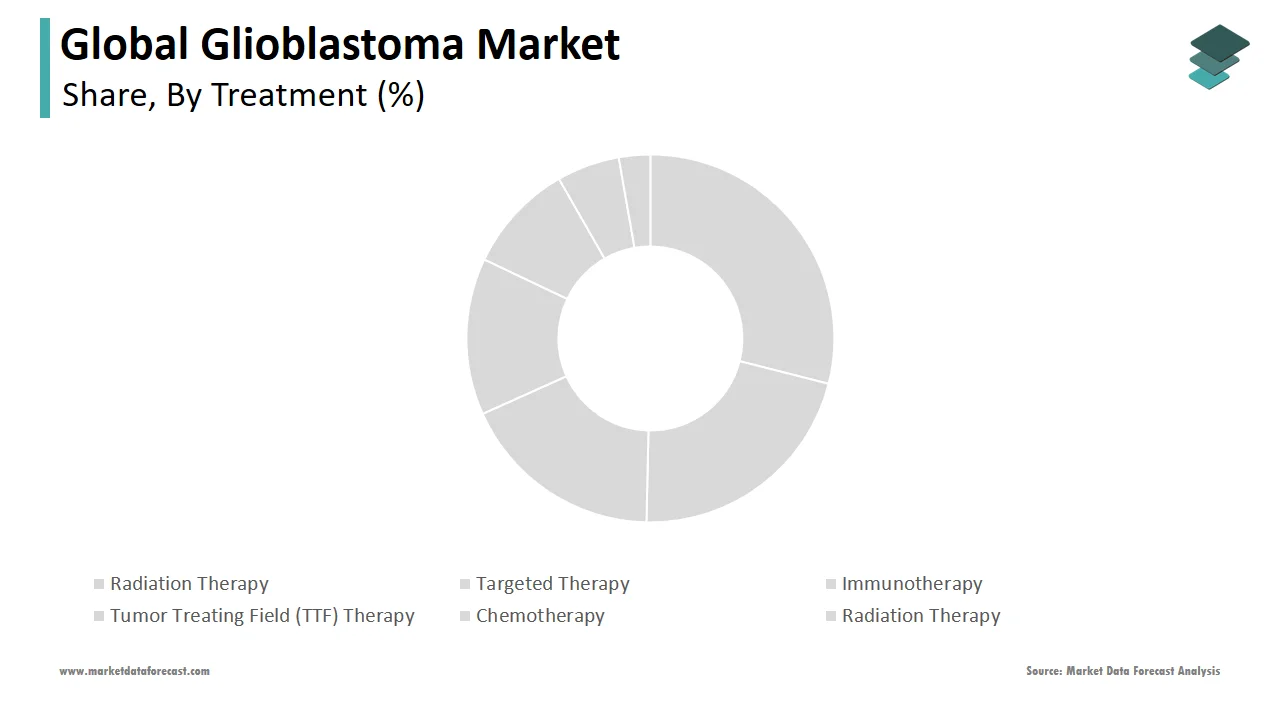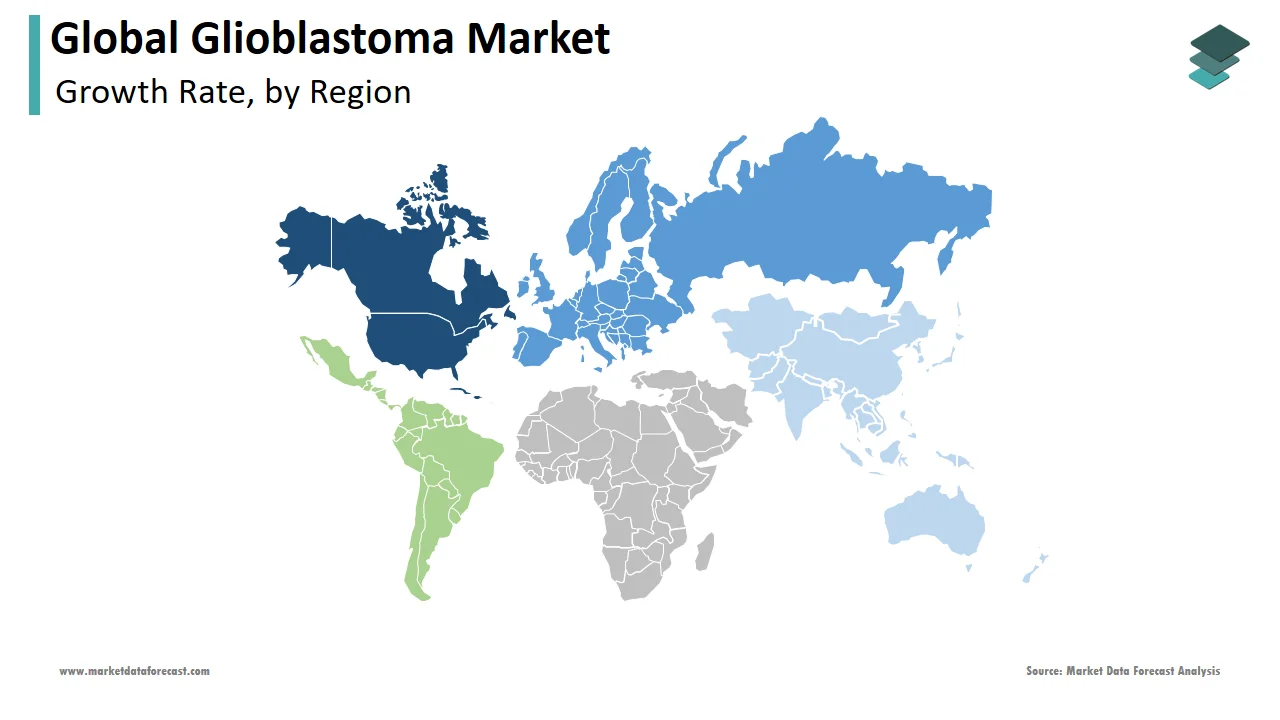Global Glioblastoma Market Size, Share, Trends & Growth Forecast By Treatment (Radiation Therapy, Targeted Therapy, Immunotherapy, Tumor Treating Field (TTF) Therapy, Chemotherapy, Radiation Therapy, Surgery), Drug Class (Lomustine, Carmustine Wafers, Bevacizumab, Temozolomide, Others), End-Use (Clinics, Ambulatory Surgical Centers, Hospitals) and Region (North America, Europe, Asia-Pacific, Latin America, Middle East and Africa), Industry Analysis From 2025 To 2033.
Global Glioblastoma Market Size
The size of the global glioblastoma market was worth USD 3.24 billion in 2024. The global market is anticipated to grow at a CAGR of 8.07% from 2025 to 2033 and be worth USD 6.51 billion by 2033 from USD 3.5 billion in 2025.

One of the most deadly and aggressive brain diseases now claiming many lives is glioblastoma, commonly known as glioblastoma multiforme (GBM). More than 20 percent of all brain tumor-related deaths are attributable to the illness. Patient with this illness has a life expectancy of fewer than 14 months, and their death is excruciating. Researchers and pharmaceutical corporations are creating medications that can lengthen patients' lives to lessen the number of fatalities. Additionally, several advancements have been made in procedures to remove tumors brought on by glioblastoma multiforme (GBM).
MARKET DRIVERS
In the upcoming years, the glioblastoma market is anticipated to be driven by the rising acceptance of innovative and combination therapies.
In June 2019, the U.S. Zirabev, a biosimilar to Avastin made by Pfizer, was given FDA approval to treat recurring cancers, including colorectal, NSCLC, and glioblastoma. As a result, the firm introduced its product in the United States in January 2020. Aside from that, in November 2019, the U.S. Samsung's SB8 bevacizumab biosimilar candidate's BLA application was approved by the FDA, increasing the likelihood that goods would be made available in the upcoming years.
Innovations and government approvals to drive glioblastoma market growth.
The need for a personalized treatment strategy to handle glioblastoma multiforme is anticipated to rise due to tumor heterogeneity and variance in patient-to-patient treatment approaches. Furthermore, the approval of new therapies is expected to lengthen the life expectancy of glioblastoma multiforme patients. Additionally, the FDA's special designation of investigational medications is expected to hasten the approval and marketing of innovative therapies. For instance, the Denovo biopharma drug DB102 (enzastaurin) was given fast-track designation by the US FDA in July 2020 for treating patients who had received a glioblastoma diagnosis.
MARKET RESTRAINTS
High costs, medicinal side effects, and low efficiency are significant hurdles for the glioblastoma market.
The primary constraints anticipated to restrain the growth of the glioblastoma multiforme are the lack of effective medicines and the inability of these therapies to prevent tumor recurrence effectively. In addition, it is expected that reimbursement challenges, strict regulatory standards, high costs, and adverse effects associated with medicines will restrain global market expansion.
REPORT COVERAGE
|
REPORT METRIC |
DETAILS |
|
Market Size Available |
2024 to 2033 |
|
Base Year |
2024 |
|
Forecast Period |
2025 to 2033 |
|
CAGR |
8.07% |
|
Segments Covered |
By Treatment, Drug Class, End-Use, and Region. |
|
Various Analyses Covered |
Global, Regional, and country-level analysis; Segment-Level Analysis, DROC; PESTLE Analysis; Porter’s Five Forces Analysis, Competitive Landscape; Analyst Overview of Investment Opportunities |
|
Regions Covered |
North America, Europe, APAC, Latin America, Middle East & Africa |
|
Market Leaders Profiled |
Sun Pharmaceutical Industries Ltd., Amgen Inc, Teva Pharmaceutical Industries Ltd., Karyopharm Therapeutics Inc., Sumitomo Dainippon Pharma Oncology, Arbor Pharmaceuticals, Pfizer Inc, F. Hoffmann-La Roche Ltd, Merck & Co Inc, Amneal Pharmaceuticals, Genetech, Bayer, Medimmune, DNAtrix, Oncoceutics, Aivita Biomedical, Medicenna Therapeutics, Diffusion Pharmaceuticals, VBL Therapeutics, and Others. |
SEGMENTAL ANALYSIS
By Treatment Insights

Due to higher survival rates, the radiation therapy segment held a share of 37.6% in 2022, dominating the market. One treatment option is to combine radiation therapy with chemotherapy and surgery. In the event of a recurrence, it is also convenient and advised for brain tumors. The tumor is more susceptible to radiation when temozolomide is added to radiotherapy. In addition, radiation therapy with temozolomide is more efficient than radiation alone.
The most frequent treatment for GBM is surgery, followed by chemotherapy and radiation therapy. The established standard of care is this course of treatment. Additionally, the category is anticipated to rise throughout the projected period due to the rising use of targeted therapy to manage GBM. The segment growth is also predicted to be boosted by increasing research efforts to create novel targeted therapies for the condition.
By Drug Class Insights
In 2024, the other segment accounted for the largest share of the glioblastoma market. Drugs such as everolimus, corticosteroids, and 5-aminolevulinic acid are included under the other drugs category (5-ALA). Corticosteroids are typically administered to lessen peritumoral vasogenic edema. Additionally, corticosteroids may have immunosuppressive effects that highlight the potential for focusing immunotherapy on a specific immune response.
A targeted therapy called bevacizumab has been approved to treat newly discovered and recurrent GBM. Additionally, the business gained full FDA approval from the United States in December 2017 to market bevacizumab for treating adults with GBM. The drug is injected intravenously to prevent the growth of new blood vessels that would otherwise cut off the tumor's blood supply. Bevacizumab is predicted to be used more frequently for treating GBM if clinical studies combine it with other treatments.
By End-Use Insights
The hospital segment had the most significant share of the global glioblastoma market in 2024 and was predicted to keep leading during the forecast period. Patients choose hospitals because they are more convenient and accessible for medical treatment. Furthermore, it is projected that the complexity of the treatment and the large number of procedures required to manage GBM will propel the market.
Over the forecast period, the clinic segment is anticipated to rise the fastest. The segment is expected to be driven by the rising uptake of non-invasive treatments, including radiation therapy and tumor-treating field therapy. In addition, the segment is expected to grow as non-invasive, patient-centered treatments like tumor-treating field therapy and external beam radiation therapy become more widely used.
Over the projection period, the ambulatory surgical center's segment is anticipated to increase profitably. In addition, the number of brain tumor resections at mobile surgical facilities may rise due to an increase in complex outpatient surgeries.
REGIONAL ANALYSIS

In 2024, North America held the highest share in the global market, and the region is expected to continue dominating the market during the forecast period. One of the main drivers of the regional market growth is government support for developing the healthcare industry, increased awareness of uncommon conditions, easy access to high-quality medical facilities, and kind reimbursement policies in countries like the U.S and Canada.
Due to several variables, including the release of generic versions of temozolomide, an improved economy, a growing elderly population, and increased healthcare investments, Asia Pacific is predicted to expand faster over the forecast period. In addition, significant unmet needs in the market, raising awareness of GBM, and a strong pipeline of compounds with the capacity to cross the blood-brain barrier are some of the primary drivers of regions like India, China, Japan, and South Korea.
KEY MARKET PLAYERS
Sun Pharmaceutical Industries Ltd., Amgen Inc, Teva Pharmaceutical Industries Ltd., Karyopharm Therapeutics Inc., Sumitomo Dainippon Pharma Oncology, Arbor Pharmaceuticals, Pfizer Inc, F. Hoffmann-La Roche Ltd, Merck & Co Inc, Amneal Pharmaceuticals, Genetech, Bayer, Medimmune, DNAtrix, Oncoceutics, Aivita Biomedical, Medicenna Therapeutics, Diffusion Pharmaceuticals, VBL Therapeutics are some of the promising companies in the global glioblastoma market.
RECENT HAPPENINGS IN THIS MARKET
- In June 2022, to treat glioblastoma (GBM) brain tumors, researchers at Georgetown Lombardi Comprehensive Cancer Center discovered biomarkers that may serve as targets for brand-new medications.
- Temozolomide (TMZ), the medicine currently used most frequently to treat glioblastoma, has the unique ability to penetrate the blood-brain barrier and attack the tumor.
- In cooperation with other labs, researchers at the University of Michigan (U-M) Rogel Cancer Center claim to have created a nanoparticle that delivered an inhibitor to mice to aid in activating the immune system to fight cancer and trigger immunological memory in glioblastoma. Their approach might one day be used to treat, stop, or postpone brain cancer relapses.
MARKET SEGMENTATION
This global glioblastoma market research report is segmented and sub-segmented into the following categories.
By Treatment
- Radiation Therapy
- Targeted Therapy
- Immunotherapy
- Tumor Treating Field (TTF) Therapy
- Chemotherapy
- Radiation Therapy
- Surgery
By Drug Class
- Lomustine
- Carmustine Wafers
- Bevacizumab
- Temozolomide
- Others
By End-Use
- Clinics
- Ambulatory Surgical Centers
- Hospitals
By Region
- North America
- Europe
- Asia Pacific
- Latin America
- Middle East and Africa
Frequently Asked Questions
What was the size of the worldwide glioblastoma market in 2024?
The global glioblastoma market size was worth USD 3.24 billion in 2024.
Which region led the market for glioblastoma worldwide in 2024?
Geographically, the North American region dominated the market for glioblastoma worldwide in 2024.
Which are the major players operating in the glioblastoma market?
Companies playing a key role in the global glioblastoma market are Sun Pharmaceutical Industries Ltd., Amgen Inc, Teva Pharmaceutical Industries Ltd., Karyopharm Therapeutics Inc., Sumitomo Dainippon Pharma Oncology, Arbor Pharmaceuticals, Pfizer Inc, F. Hoffmann-La Roche Ltd, Merck & Co Inc, Amneal Pharmaceuticals, Genetech, Bayer, Medimmune, DNAtrix, Oncoceutics, Aivita Biomedical, Medicenna Therapeutics, Diffusion Pharmaceuticals, VBL Therapeutics.
Related Reports
Access the study in MULTIPLE FORMATS
Purchase options starting from $ 2500
Didn’t find what you’re looking for?
TALK TO OUR ANALYST TEAM
Need something within your budget?
NO WORRIES! WE GOT YOU COVERED!
Call us on: +1 888 702 9696 (U.S Toll Free)
Write to us: [email protected]
